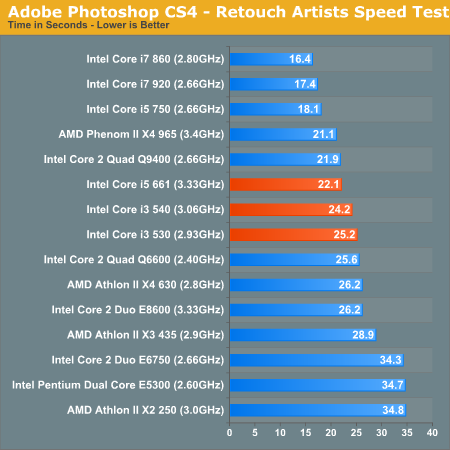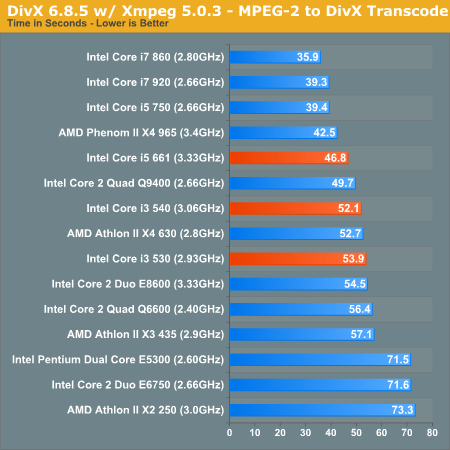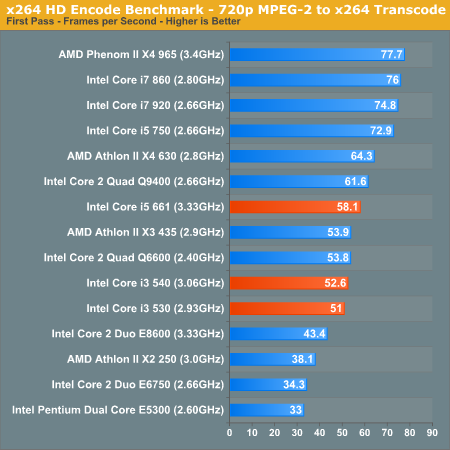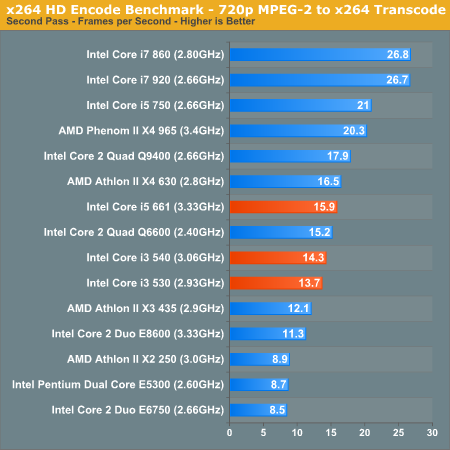The Clarkdale Review: Intel's Core i5 661, i3 540 & i3 530
by Anand Lal Shimpi on January 4, 2010 12:00 AM EST- Posted in
- CPUs
Adobe Photoshop CS4 Performance
To measure performance under Photoshop CS4 we turn to the Retouch Artists’ Speed Test. The test does basic photo editing; there are a couple of color space conversions, many layer creations, color curve adjustment, image and canvas size adjustment, unsharp mask, and finally a gaussian blur performed on the entire image.
The whole process is timed and thanks to the use of Intel's X25-M SSD as our test bed hard drive, performance is far more predictable than back when we used to test on mechanical disks.
Time is reported in seconds and the lower numbers mean better performance. The test is multithreaded and can hit all four cores in a quad-core machine.

And this is where everything changes. While our Photoshop test won't keep four cores busy 100% of the time, it's enough to give the quad-core CPUs an advantage. Here the Core i5 661 is around the speed of a Q9400 but nowhere near the similarly priced Lynnfield Core i5 750.
The Core i3 540/530 are valuable as they are both able to outperform AMD's similarly priced Athlon II X4 630. The 661 doesn't make sense here but for the price, the i3 530/540 look promising.
DivX 8.5.3 with Xmpeg 5.0.3
Our DivX test is the same DivX / XMpeg 5.03 test we've run for the past few years now, the 1080p source file is encoded using the unconstrained DivX profile, quality/performance is set balanced at 5 and enhanced multithreading is enabled:

Video encoding is where you need more cores, and this is where the Core i5 661 really loses out in terms of value. It's the same price as a Core i5 750 but it's clearly slower. Turbo isn't saving the 661.
The Core i3 540 and 530 however look competitive. They're able to perform at around the same level as AMD's Athlon II X4 630, while drawing much less power.
x264 HD Video Encoding Performance
Graysky's x264 HD test uses the publicly available x264 encoder to encode a 4Mbps 720p MPEG-2 source. The focus here is on quality rather than speed, thus the benchmark uses a 2-pass encode and reports the average frame rate in each pass.

Competitive in DivX encoding, yes. But in our x264 encoding test, these Clarkdales just don't make sense. If you do a lot of x264 video encoding you're going to want Lynnfield or a quad-core Athlon II/Phenom II.

Windows Media Encoder 9 x64 Advanced Profile
In order to be codec agnostic we've got a Windows Media Encoder benchmark looking at the same sort of thing we've been doing in the DivX and x264 tests, but using WME instead.

Rounding out our video encoding tests Windows Media Encoder 9 doesn't really show us anything different. The Core i5 661 is slower than it should be given its price, and here even the i3s lose out. If you do a lot of encoding, you want four cores. Simple as that.










93 Comments
View All Comments
yuhong - Monday, January 4, 2010 - link
"The Clarkdale lineup is honestly made up of CPUs that are too expensive. The Core i5 670, 661/660 and 650 are all priced above $170 and aren’t worth the money. The problem is Lynnfield’s turbo mode gives you high enough clock speeds with two threads that there’s no need to consider a dual-core processor. You can buy a Core i5 750, have more cores than any of these Clarkdales and run at close enough to the same frequencies for $196."But then you have to pay extra for a discrete graphic card and not every application need the extra graphic power!
Paulman - Monday, January 4, 2010 - link
Wow, I was going to write about how you wouldn't have to buy a discrete graphics card if you went with a Core i5 750 because you could just choose a motherboard with an integrated graphics chip. But then I checked online and it seems that there aren't any P55-based boards with integrated graphics - wow! Wouldn't have believed it myself.However, Anand's point still stands when comparing the Clarkdale i5's to the Phenom II X4, for which you can get many boards with integrated graphics.
Inkie - Sunday, January 10, 2010 - link
"when comparing the Clarkdale i5's to the Phenom II X4, for which you can get many boards with integrated graphics"...but Clarkdale already has integrated graphics.
ssj4Gogeta - Friday, January 8, 2010 - link
It's because P55 is a southbridge, not a northbridge.Taft12 - Monday, January 4, 2010 - link
But then you have to pay extra for a discrete graphic card and not every application need the extra graphic power!Only if you don't already have any PCI-E x16 card. Is that true for a single reader of this site? And truly ANY PCI-E card will perform better than Intel's on-chip solution, even one 3 generations old.
ereavis - Monday, January 4, 2010 - link
so the price goes up another $30-$40. As to your question of truth, yes I spend 40 hours a week on an intel IGP dual core as it is, so do the other 1000 people in this building doing engineering work that's processor demanding but graphics independent.nubie - Monday, January 4, 2010 - link
There are rafts of HP 8400 OEM pci-e cards on ebay right now for $15 (total, no shipping or tax), that should even accelerate your Flash 10.1 and video just fine.If you even need it that is, and it is clear that for many there is absolutely no use for more than the integrated graphics.
oc3an - Monday, January 4, 2010 - link
Hi Anand. Looks to me like something weird is up with your Everest benchmarks. Shouldn't the 24X multiplier have the faster scores?-Patrick
Rajinder Gill - Monday, January 4, 2010 - link
Hi Patrick,Fixed it, the images were reversed.
Thanks!
Raja
maxfisher05 - Monday, January 4, 2010 - link
Good Article Anand. I'm going to be building my first HTPC soon, but I want to be able to do some light gaming on it, and it doesn't look like the integrated graphics have come far enough yet. If the 661 was priced lower I would consider it, but for nearly the price of a 750 you are right in saying it makes no sense. 750 + 5750 discrete graphics for me please :)Will someone be posting an updated system buyers' guide soon?